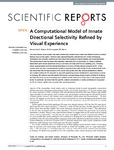A Computational Model of Innate Directional Selectivity Refined by Visual Experience
| dc.contributor.author | Adams, SV | |
| dc.contributor.author | Harris, Chris | |
| dc.date.accessioned | 2015-09-25T12:22:15Z | |
| dc.date.available | 2015-09-25T12:22:15Z | |
| dc.date.issued | 2015-12 | |
| dc.identifier.issn | 2045-2322 | |
| dc.identifier.issn | 2045-2322 | |
| dc.identifier.other | 12553 | |
| dc.identifier.uri | http://hdl.handle.net/10026.1/3552 | |
| dc.description.abstract |
<jats:title>Abstract</jats:title><jats:p>The mammalian visual system has been extensively studied since Hubel and Wiesel’s work on cortical feature maps in the 1960s. Feature maps representing the cortical neurons’ ocular dominance, orientation and direction preferences have been well explored experimentally and computationally. The predominant view has been that direction selectivity (DS) in particular, is a feature entirely dependent upon visual experience and as such does not exist prior to eye opening (EO). However, recent experimental work has shown that there is in fact a DS bias already present at EO. In the current work we use a computational model to reproduce the main results of this experimental work and show that the DS bias present at EO could arise purely from the cortical architecture without any explicit coding for DS and prior to any self-organising process facilitated by spontaneous activity or training. We explore how this latent DS (and its corresponding cortical map) is refined by training and that the time-course of development exhibits similar features to those seen in the experimental study. In particular we show that the specific cortical connectivity or ‘proto-architecture’ is required for DS to mature rapidly and correctly with visual experience.</jats:p> | |
| dc.format.extent | 0-0 | |
| dc.format.medium | Electronic | |
| dc.language | en | |
| dc.language.iso | en | |
| dc.publisher | Springer Science and Business Media LLC | |
| dc.subject | Humans | |
| dc.subject | Long-Term Potentiation | |
| dc.subject | Models, Biological | |
| dc.subject | Models, Neurological | |
| dc.subject | Neuronal Plasticity | |
| dc.subject | Orientation | |
| dc.subject | Visual Cortex | |
| dc.subject | Visual Fields | |
| dc.subject | Visual Perception | |
| dc.title | A Computational Model of Innate Directional Selectivity Refined by Visual Experience | |
| dc.type | journal-article | |
| dc.type | Journal Article | |
| plymouth.author-url | https://www.webofscience.com/api/gateway?GWVersion=2&SrcApp=PARTNER_APP&SrcAuth=LinksAMR&KeyUT=WOS:000358769400001&DestLinkType=FullRecord&DestApp=ALL_WOS&UsrCustomerID=11bb513d99f797142bcfeffcc58ea008 | |
| plymouth.issue | 0 | |
| plymouth.volume | 5 | |
| plymouth.publication-status | Published online | |
| plymouth.journal | Scientific Reports | |
| dc.identifier.doi | 10.1038/srep12553 | |
| plymouth.organisational-group | /Plymouth | |
| plymouth.organisational-group | /Plymouth/Faculty of Health | |
| plymouth.organisational-group | /Plymouth/Research Groups | |
| plymouth.organisational-group | /Plymouth/Research Groups/Centre for Brain, Cognition and Behaviour (CBCB) | |
| plymouth.organisational-group | /Plymouth/Research Groups/Centre for Brain, Cognition and Behaviour (CBCB)/Brain | |
| plymouth.organisational-group | /Plymouth/Users by role | |
| dc.publisher.place | England | |
| dcterms.dateAccepted | 2015-07-01 | |
| dc.identifier.eissn | 2045-2322 | |
| dc.rights.embargoperiod | No embargo | |
| rioxxterms.versionofrecord | 10.1038/srep12553 | |
| rioxxterms.licenseref.uri | http://www.rioxx.net/licenses/all-rights-reserved | |
| rioxxterms.licenseref.startdate | 2015-12 | |
| rioxxterms.type | Journal Article/Review |


